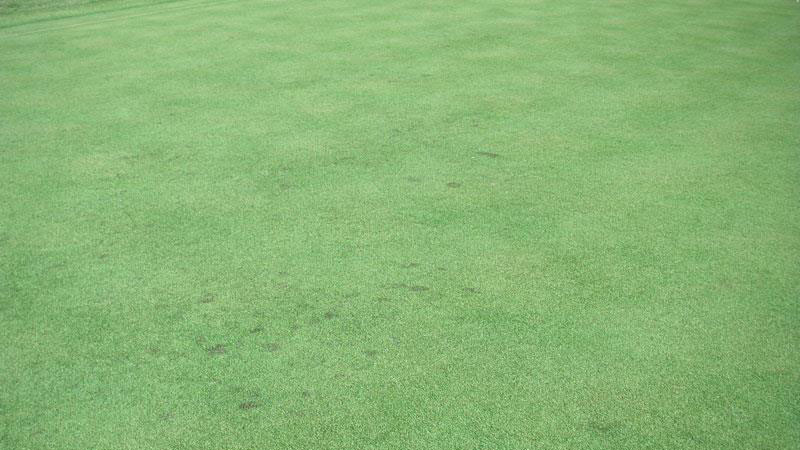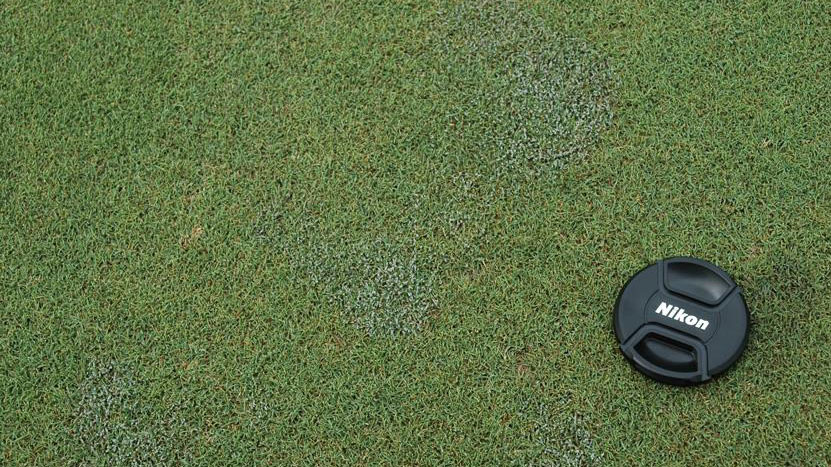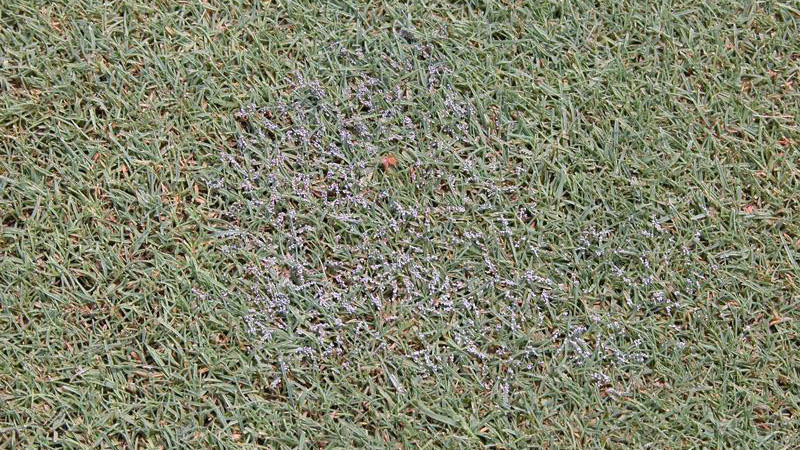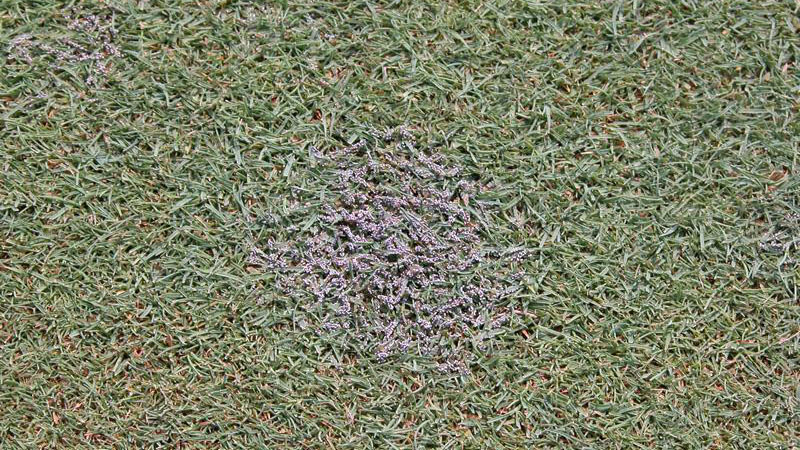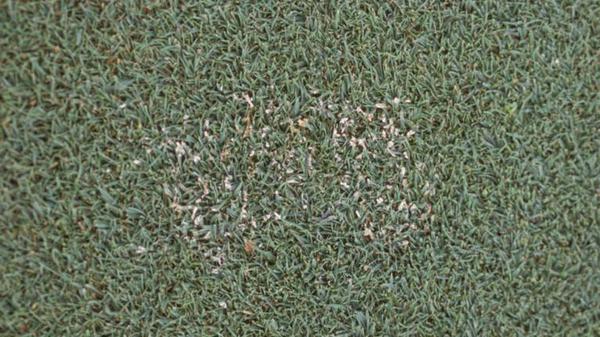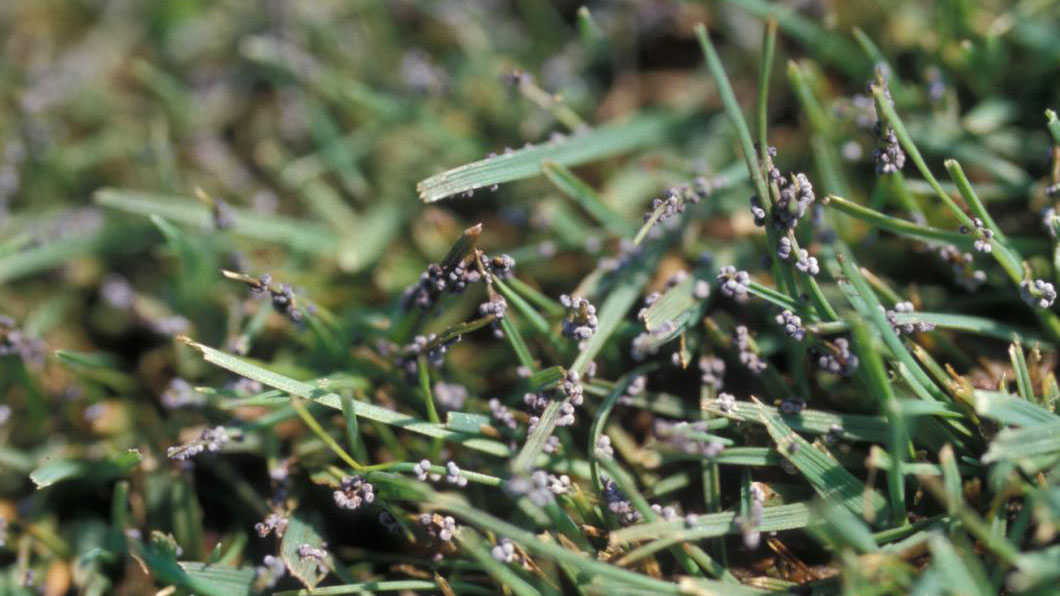Symptoms
Many small, round pustules are observed on the turfgrass leaves in small patches. The patches develop very quickly, usually overnight. The pustules may be purple, white, gray, yellow, or orange in color. The slime mold organisms do not infect the turf or cause direct harm, but they can cause mild yellowing of the leaves due to their shading effect. Slime molds are unsightly but are not considered harmful.
Development Factors
Slime mold spores survive in the soil and thatch. During warm, wet weather the spores germinate and develop into a slimy mass that grows over the soil and nearby plant parts during wet weather. The pustules observed on turfgrass leaves are reproductive structures that contain numerous spores.
Flushes of slime mold growth are often observed after heavy rain storms that were preceded by long periods of dry weather.
Cultural Control
Slime mold pustules typically disappear after 2 to 3 days; therefore, no control practices are needed. If the growth is particularly unsightly, the pustules may be removed by brushing, mowing, or washing the turf.
Chemical Control
Fungicides are available for slime mold control but are only necessary in severe cases.
* Products marked with an asterisk are not labeled for home lawn use.
| Fungicide and Formulation1 | Amount of Formulation2 | Application Interval (Days)3 | Efficacy Rating | Resistance Risk | FRAC Code4 |
| mancozeb (Fore)* | 4 to 8 | 10 | +++ | Low | M3 |
| 1 Other trade names with the same active ingredients are labeled for use on turfgrasses and can be used according to label directions. 2 Units are oz, fl oz, or lb depending on formulation. Apply fungicides in 2 to 5 gallons of water per 1,000 square feet according to label directions. Use lower rates for preventive and higher rates for curative applications. 3 Use shorter intervals when conditions are very favorable for disease. 4 Fungicide Resistance Action Committee code. Products with same code have the same mode of action and are in the same chemical class. * Products marked with an asterisk are not labeled for home lawn use. |
|||||
| Efficacy Rating ++++ = excellent control when conditions are highly favorable for disease development +++ = good control when disease pressure is high, excellent control when disease pressure is moderate ++ = good control when disease pressure is moderate, excellent control when disease pressure is low + = good control when disease pressure is low ? = not rated due to insufficient data |
|||||
| Resistance Risk Low = Rotate to different chemical class after 3-4 applications; tank mixing not necessary Medium = Rotate to different chemical class after 1-2 applications; tank-mixing with low or medium risk product recommended High = Rotate to different chemical class after EVERY application; tank-mix with low or medium risk product for EVERY application ? = not rated due to insufficient data |
|||||
Species Data
- HOST SPECIES
- all
- MONTHS WITH SYMPTOMS
- April to September
- STAND SYMPTOMS
- FOLIAR SYMPTOMS LOCATION / SHAPE
- FOLIAR SYMPTOMS COLOR
- all
- ROOT / CROWN SYMPTOMS
- none
- FUNGAL SIGNS
- pustules
Publication date: Nov. 10, 2017
Reviewed/Revised: Dec. 16, 2019
Recommendations for the use of agricultural chemicals are included in this publication as a convenience to the reader. The use of brand names and any mention or listing of commercial products or services in this publication does not imply endorsement by NC State University or N.C. A&T State University nor discrimination against similar products or services not mentioned. Individuals who use agricultural chemicals are responsible for ensuring that the intended use complies with current regulations and conforms to the product label. Be sure to obtain current information about usage regulations and examine a current product label before applying any chemical. For assistance, contact your local N.C. Cooperative Extension county center.
N.C. Cooperative Extension prohibits discrimination and harassment regardless of age, color, disability, family and marital status, gender identity, national origin, political beliefs, race, religion, sex (including pregnancy), sexual orientation and veteran status.

